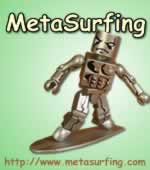
Now, the picture above is pretty unremarkable, right? Black and white (trivia: molecules have no color), grainy, shot in the kind of out-of-focus manner you expect from a guy like me, who can't seem to venture out beyond the Auto setting on his entry-level Nikon D40 DSLR. But wait a second. Doesn't the image kind of seem, well, familiar? Like high school chem class familiar? Balls and sticks familiar?
Here's another image; a computer generated image that's much more at home for anyone who studied atoms and molecules in the dead and gone days of 1997:
 Make sense now? That B&W structure is an actual image of a molecule and its atomic bonds. The first of its kind, in fact, and a breakthrough for the crazy IBM scientists in Zurich who spent 20 straight hours staring at the "specimen"—which in this case was a 1.4 nanometer-long pentacene molecule comprised of 22 carbon atoms and 14 hydrogen atoms.
Make sense now? That B&W structure is an actual image of a molecule and its atomic bonds. The first of its kind, in fact, and a breakthrough for the crazy IBM scientists in Zurich who spent 20 straight hours staring at the "specimen"—which in this case was a 1.4 nanometer-long pentacene molecule comprised of 22 carbon atoms and 14 hydrogen atoms.
You can actually make out each of those atoms and their bonds, and it's thanks to this: An atomic force microscope.
 Like the venerable electron microscope, but more powerful and with an eye for the third dimension, the AFM is able to make the nano world something we humans can appreciate visually. Using a silicon microscale cantilever coated in carbon dioxide (tiny, tiny needle), lasers, an "ultrahigh vacuum" and temperatures that hovered around 5 Kelvin, the AFM imaged the pentacene in nanometers. It did this while sitting a mere 0.5 nanometers above the surface and its previously invisible bonds for 20 long, unmoving hours. The length of time is noteworthy, said IBM scientist Leo Goss in statement from IBM, because any movement whatsoever would have disrupted the delicate atomic bonds and ruined the image.
Like the venerable electron microscope, but more powerful and with an eye for the third dimension, the AFM is able to make the nano world something we humans can appreciate visually. Using a silicon microscale cantilever coated in carbon dioxide (tiny, tiny needle), lasers, an "ultrahigh vacuum" and temperatures that hovered around 5 Kelvin, the AFM imaged the pentacene in nanometers. It did this while sitting a mere 0.5 nanometers above the surface and its previously invisible bonds for 20 long, unmoving hours. The length of time is noteworthy, said IBM scientist Leo Goss in statement from IBM, because any movement whatsoever would have disrupted the delicate atomic bonds and ruined the image.
And that's the real beauty of this image. For the first time ever we can see where each of those carbon and hydrogen atoms line up, and the overall symmetrical shape they create. In 3D.

 Researchers at Carnegie Mellon University have developed novel approaches to humanoid robot navigation and path planning using a Honda Asimo and HRP-2 Promet as their test subjects. The robots are able to perceive obstacles in their environment and walk around them to reach a goal destination. They can even predict the velocity of moving obstacles and time their footsteps in order to get through unharmed using computer vision algorithms.
Researchers at Carnegie Mellon University have developed novel approaches to humanoid robot navigation and path planning using a Honda Asimo and HRP-2 Promet as their test subjects. The robots are able to perceive obstacles in their environment and walk around them to reach a goal destination. They can even predict the velocity of moving obstacles and time their footsteps in order to get through unharmed using computer vision algorithms.
